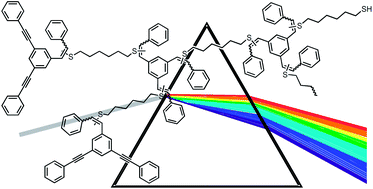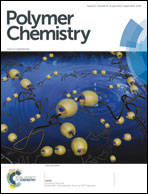High refractive index polyvinylsulfide materials prepared by selective radical mono-addition thiol–yne chemistry†
Abstract
We report on a new framework for preparing high-refractive index polymeric materials which combines the selective thiol radical mono-addition to phenyl-acetylene derivatives with hyperbranched architectures. Using this strategy we have synthesized a series of linear and hyperbranched polyvinyl sulfide (PVS) materials, employing different dithiol (A2 and A′2) and di- and trialkyne (B2 and B3) monomers. The process requires only a simple radical initiator, such as AIBN, in lieu of expensive or toxic catalysts and this chemistry produces polymers in high yield (up to 96%) and high molecular weight (up to 123 000 g mol−1). The polymers are optically transparent, thermally stable (up to 420 °C) and readily form high-quality films. The end group composition of the hyperbranched materials can be easily adjusted by changing the A2/B3 feed ratio. The sulfur incorporation and conjugation resulting from thiol–yne coupling with selective mono-addition results in materials with high refractive indices in the visible and IR region (nD = 1.68–1.75) and optical dispersions as low as 0.004. Moreover, we demonstrate that the hyperbranched architecture produces materials with better performance in terms of light reflection and chromatic dispersion compared to linear structures.


 Please wait while we load your content...
Please wait while we load your content...